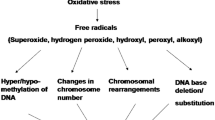Summary
Crosses were made between five cultivars of Hordeum vulgare and three genotypes of H. bulbosum and the influence of male and female partners on success rates up to the stage of haploid embryo culture was investigated. Both parents markedly affected seed setting and rates of embryo differentiation, whereas seed quality was mainly influenced by the female. There was an interaction between certain genotypes when overall embryo culture rates were analysed. Following embryo culture only the influence of the female partner was assessed but differences were found between the H. vulgare cultivars regarding rates of hybrid (VB) production and chromosome doubling whereas total plant regeneration was unaffected.
Similar content being viewed by others
References
Adamski, T., 1979. The obtaining of autodiploid barley lines using haploids from the cross Hordeum vulgare L. x Hordeum bulbosum L. Genetica Polonica 20: 31–42.
Foroughi-Wehr, B., R. A. Pickering & W. Friedt, 1981. Related response of barley cultivars to the ‘bulbosum’-and anther-culture techniques of haploid production. Barley Genetics Newsletter 11: 54–59.
Fukuyama, T. & R. Takahaski, 1976. A study of the interspecific hybrid,Hordeum bulbosum (4x) x H. vulgare (4x) with special reference to dihaploid frequency. Proc. int. Barley Genet. Symp. 3: 351–360.
Gamborg, O. L., R. A. Miller & K. Ojima, 1968. Nutrient requirements of suspension cultures of soybean root cells. Experimental Cell Research 50: 151–158.
Jensen, C. J., 1976. Barley monoploids and doubled monoploids: techniques and experience. Proc. int. Barley Genet. Symp. 3: 316–345.
Jensen, C. J., 1977. Monoploid production by chromosome elimination. In: J. Reinert & Y. P. S. Bajaj (Eds), Applied and fundamental aspects of plant cell, tissue and organ culture. pp. 299–330, Springer-Verlag, Berlin.
Jensen, C. J., 1982. Haploid production through chromosome elimination in cereal crops. In: Cell and tissue culture techniques in cereal improvement. Proc. int. Workshop, Peking 1981. Science Press, Peking, China.
Jones, I. T. & R. A. Pickering, 1978. The mildew resistance of Hordeum bulbosum and its transference into H. vulgare genotypes. Ann. appl. Biol. 88: 295–298.
Kasha, K. J. & K. N. Kao, 1970. High frequency haploid production in barley (Hordeum vulgare L.). Nature 225: 874–876.
Novák, F. J., F. Minařík, L. Ohnoutková & J. Bouma, 1977. Production of haploid barley (Hordeum vulgare L.) and wheat (Triticum aestivum L.) in interspecific hybridization with Hordeum bulbosum L. In: F. J. Novák (Ed.), Use of tissue cultures in plant breeding. Proc. int. Symp. Olomouc, Czechoslovakia 1976, pp. 427–439, Czechoslovak Acad. Sci., Prague.
Pickering, R. A., 1979a. Further investigations on partial incompatibility in crosses between Hordeum vulgare L. and H. bulbosum L. In: A. C. Zeven & A. M. van Harten (Eds), Proc. Conf. Broadening Genet. Base Crops, Wageningen 1978, pp. 319–325 Pudoc, Wageningen.
Pickering, R. A., 1979b. Partial incompatibility between Hordeum vulgare L. and H. bulbosum L. Incompatibility Newsletter 11: 27–29.
Pickering, R. A., 1980a. Attempts to overcome partial incompatibility between Hordeum vulgare L. and H. bulbosum L. Euphytica 29: 369–377.
Pickering, R. A., 1980b. use of the doubled haploid technique in barley breeding at the Welsh Plant Breeding Station. In: Rep. Welsh Pl. Breed. Stn for 1979, pp. 208–226.
Pickering, R. A. & J. D. Hayes, 1976. Partial incompatibility in crosses between Hordeum vulgare L. and H. bulbosum L. Euphytica 25: 671–678.
Pickering, R. A. & P. W. Morgan, 1979. Production of doubled haploid barley. In: Rep. Welsh Pl. Breed. Stn for 1978, pp. 84–85.
Pickering, R. A. & P. W. Morgan, 1982. Double haploid barley. In: Rep. Welsh Pl. Breed. Stn for 1981, pp. 76–78.
Pickering, R. A. & P. W. Morgan, 1983. Plant regeneration from cultured embryos derived from Hordeum vulgare L. pollinated with H. Bulbosum L. Euphytica 32: 585–591.
Simpson, E., J. W. Snape & R. A. Finch, 1980. Variation between Hordeum bulbosum genotypes in their ability to produce haploids of barley,Hordeum vulgare. Z. Pflanzenzüchtg 85: 205–211.
Tanner, D. G., 1981. Parental effects on chromosome doubling for the production of primary triticale. Can. J. Genet. Cytol. 23: 191–193.
Zadoks, J. C., T. T. Chang & C. F. Konzak, 1974. A decimal code for the growth stages of cereals. Weed Research 14: 415–421.
Author information
Authors and Affiliations
Rights and permissions
About this article
Cite this article
Pickering, R.A. The influence of genotype on doubled haploid barley production. Euphytica 32, 863–876 (1983). https://doi.org/10.1007/BF00042168
Received:
Issue Date:
DOI: https://doi.org/10.1007/BF00042168




